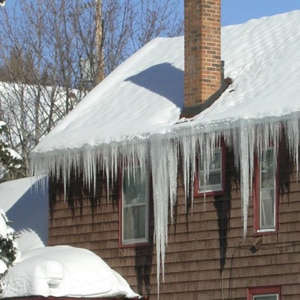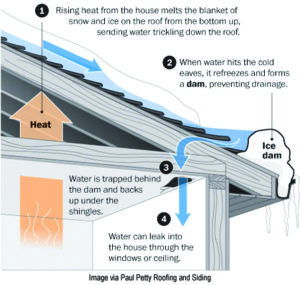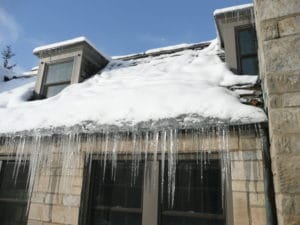What’s the Big Deal About Roof Ice Dams?
 They’re actually fairly pretty, and many roof ice dams look like white frosting just dripping off the house. But looks can be deceiving.
They’re actually fairly pretty, and many roof ice dams look like white frosting just dripping off the house. But looks can be deceiving.
Roof ice dams are those thick ridges of ice hanging from your home’s eaves, gutters or siding. When ice dams form, they can weigh down and potentially break gutters.
Roof ice dams can also block melting snows from properly draining and can lead to roof leaks. The common thinking is that the closer the roof ice dams are to the house, the more troublesome they can be to your home.
How are Roof Ice Dams Formed?
 In many homes, warm air inside the house escapes into the attic if not properly insulated. This will warm the underside of the roof, causing snow and ice on the roof to melt.
In many homes, warm air inside the house escapes into the attic if not properly insulated. This will warm the underside of the roof, causing snow and ice on the roof to melt.
The melted water will drain along the roof, under the snow, until it reaches the cold overhang. The overhang tends to be at the same temperature as the outdoors. When that happens the melted water will refreeze and form roof ice dams and icicles.
The ice dam can cause damage to the roof, which will result in water leaks to the inside. Frequently the result will be a water spot on the ceiling under the roof damage.
What to do about Roof Ice Dams
Taking a shovel and knocking off overhanging icicles isn’t the solution. Neither is pouring hot water on the ice. Click HERE for a prescription checklist from ENERGY STAR that gives tips on handling roof ice dams. The checklist also tells how to prevent them from reoccurring on your roof.
And, remember that even though winter weather may be in your past, roof ice dams will still haunt you. Why? Because the weight and damage done during the winter months by roof ice dams can cause concerns for your roof the remainder of the year.

Saving Your Roof
Once the snow and ice is gone, prepare your home for the future by making sure to insulate your attic to help prevent the melting-and-freezing cycle that causes roof ice dams to form in the first place. This involves sealing any place where warm air could leak from your house to the attic, including vent pipes, exhaust fans, chimneys, attic hatches and light fixtures.
Also, if you’re replacing your roof this year, experts at DaVinci Roofscapes recommend you make certain that a self-adhered membrane is placed beneath the new tiles. This can serve as an added barrier that helps prevent water from seeping inside the home.
Don’t wait until roof ice dams turn your home into a fairy castle of icicles. Take time now to evaluate damage caused by freezing roof ice dams last year and to get ready upcoming winter weather!